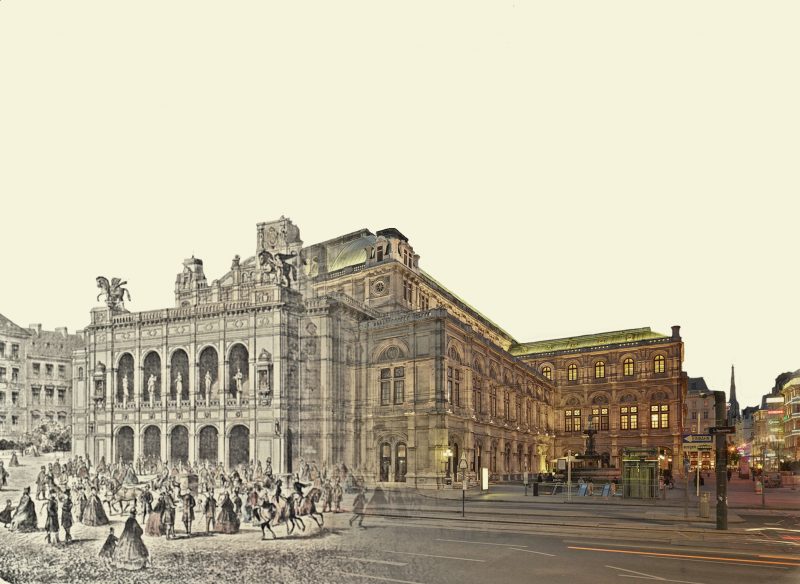Speaking at a press conference held recently in the Austrian Residence, in London’s Belgrave Square, the Director of the Vienna State Opera, Dominique Meyer, revealed that, during the 2017/2018 season, the ‘Wiener Staatsoper live at home’ programme will broadcast a total of 45 performances live on the internet.
In addition to the opera house’s own portal. at www.staatsoperlive.com, performances can be streamed directly on Amazon Fire TV (box or stick – app: WIENER STAATSOPER LIVE); Apple TV (Generation 4, since the end of 2015 – app search: WIENER STAATSOPER); A1TV Mediabox (menu item internet apps: WIENER STAATSOPER LIVE); Samsung and Android Smart TVs (app: WIENER STAATSOPER).
The Wiener Staatsoper is also now employing this technology for a live schools’ programme – ‘Wiener Staatsoper live at school’. Making the Vienna Stat Opera’s portfolio available to large numbers of young people throughout Austria and abroad, this technology enables students to discover the opera house and its many professions, experience live rehearsals, and watch live broadcasts of opera or ballet performances during school hours, thanks to time-shifted broadcasts.
WIENER STAATSOPER live at home
Available worldwide both live and in time-shifted broadcasts, via the internet on computers, Smart TVs or mobile devices, ‘Wiener Staatsoper live at home’ is currently the only such service on the market. However, Mr Meyer commented that, following the continued success of the Vienna State Opera service, the Berlin State Opera is likely to launch a similar offering in the coming months.
The ‘Wiener Staatsoper live at home’ broadcasts start 30 minutes before the performance with backstage views, information about the Wiener Staatsoper and the artists, synopses of the streamed works, and so on. During the intervals, viewers are shown various editorial content including interviews.
Viewers can switch between two live channels of the same performance at any time while watching. One channel shows a complete view of the stage, while the other offers a live cut of the opera with closeups and moving cams.
Moreover, viewers can access synchronized multilingual subtitles, a ‘moving score’ functionality and – for selected performances – historic scores from Vienna State Opera’s archives.
A yearly subscription to ‘Wiener Staatsoper live at home’ costs € 159 or € 16.90 per month. To see a single opera costs € 14.
Those wanting a multimedia progamme booklet can download one via the Wiener Staatsoper Publications App. There’s also a video store offering copies of current and historical productions for rent via on-demand streams.
All details about the 2018/2019 season of WIENER STAATSOPER live at home as well as the tickets/packages can be found at www.staatsoperlive.com
Cost-cutting Technology
“Costs can make the ‘traditional’ broadcast of performances prohibitive,” said Mr Meyer. “Typically, such a broadcast would cost some € 200,000.
“Consequently, we have an arrangement with a national broadcaster to use our – much cheaper – in-house, nine-camera system to broadcast a performance. Everything is done in-house – and now, after having produced over 200 broadcasts via ‘Wiener Staatsoper live at home’, our in-house team is both skilled and experienced. Moreover, the in-house cameras don’t require the house and stage lights to be modified – and that saves everyone time and money.
“So, we now send pictures direct to the national broadcaster – and the overall costs of producing the performance for broadcast are very low – not even ten per cent of the ‘traditional’ broadcast cost.
“Music producers – such as opera houses – should invest in this technology,” Mr Meyer stated. “They shouldn’t wait for broadcasters to come to them. Rather, they should find low cost ways to take their music to a wider audience – as we’re doing, through the technology we have at the opera house.”
Tablet Technology in the Opera House
According to Mr Meyer, the Vienna State Opera House has done away with the need for surtitle screens by installing tablets in each of the house’s seats. These tablets offer a translation of the action on stage in six languages: German, English, Italian, French, Russian and Japanese.
“We’re going to add Spanish and Chinese to these options too,” he revealed. “Indeed, the system is so successful that La Scala opera house in Milan, and the Metropolitan Opera in New York are also contemplating using the same system.
Celebrating the Past
At the press conference, Mr Meyer also announced the opera house’s programme for the 2018/19 season and gave details of the activities commemorating “150 Years of the Vienna Opera House”.
The 2018/2019 schedule includes over 300 performances of 50 operas and 16 ballets, along with five children’s programmes. In addition, numerous concerts, matinées and special events are planned.
Vienna’s opera tradition dates from the early Baroque period – notably the early 18th century, when opera performances took mainly place at the imperial court. In December 1857, Emperor Franz Joseph I decreed that the old inner-city fortifications would be torn down and replaced by a broad boulevard – the Ring – with new buildings dedicated to the various cultural and political institutions. This included relocating the court theatres for drama and opera on the Ring.
On 25th May 1869, the opera house was opened with a performance of Mozart’s Don Juan (Don Giovanni) – given in German – in the presence of the Emperor Franz Joseph and his wife, Empress Elisabeth.
During World War II the house was almost destroyed during a bombing raid. So, on 1st May 1945, the ‘State Opera in the Volksoper’ put on a performance of Mozart’s Le nozze di Figaro. There followed, on 6th October 1945, the reopening of the restored ‘Theater an der Wien’, with a performance of Beethoven’s Fidelio. So, for the next ten years, there were two theatres where performances could take place while the Vienna State Opera house was restored.
Only the opera house’s main façade, the grand staircase, the emperor’s tea room and the ‘Schwind-Foyer’ had been spared by the bombs, so there was much renovation work to be done. With great ceremony, on 5th November 1955, the opera house reopened with a performance of Fidelio.
Over the years, the opera house has witnessed the world premiere of such works as Jules Massenet’s Werther, Richard Strauss’s Viennese version of Ariadne auf Naxos as well as his Die Frau ohne Schatten, Alfred Schnittke’s Gesualdo and, most recently, Aribert Reimann’s Medea.
The house’s most notable directors include Gustav Mahler (1897-1907), Richard Strauss, Clemens Krauss, Karl Böhm, Herbert von Karajan and Lorin Maazel.
Key achievements during the last two decades, under the direction of Ioan Holender, include the foundation of the Opera School for Children (in 2001), the installation of devices for the subtitles in the auditorium (in 2001) and the ‘Opera live on the Square’ project providing live broadcasts of several performances to viewers in Herbert von Karajan Square (from 2009).







Leave A Comment
You must be logged in to post a comment.